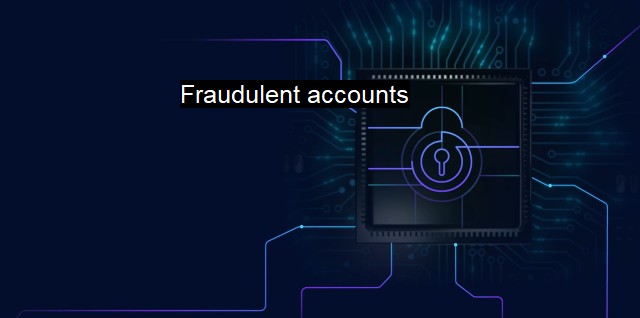What are Fraudulent accounts?
The Growing Threat of Fraudulent Accounts: How Fake Identities Put Businesses at Risk in the Digital Age
Fraudulent accounts are deceptive and maliciously created profiles that operate under stolen, false, or synthesized identities. Their main purpose is to perpetrate damaging activities, fraudulent activities, or to disseminate misinformation, usually from behind a veil of anonymity provided by the false identity. These fraudulent accounts are a considerable threat in the digital world, enabling criminals to conduct a wide array of malfeasance such as identity theft, cyber stalking, spreading false news, and executing phishing scams, among other online criminal activities.This compromise of integrity is often orchestrated by intelligent cyber criminals who employ sophisticated techniques in subverting cyber-security measures, and these perpetrators operate at the small scale to the incredibly large scale; from impersonating individuals in credit card fraud, to posing as institutions and dictating fabricated narratives used to sway public opinion. When considering the global interconnectedness of the digital world and its core role in our society, the potential for destruction is immense.
Conceivably, the most prevalent and damaging type of fraudulent account is one which impersonates a genuine person and engages in identity theft. Using these fake profiles, cyber criminals can gather personal information, manipulate others, or con unsuspecting victims out of money. They defraud people by fooling them into trusting the verified authenticity that an online identity usually confers. Criminals often duplicate real accounts, mimicking the actual users right down to their online activity, in order to augment the profile's credibility.
Fraudulent accounts pose a significant threat. These accounts can circumnavigate security systems, pose as genuine account holders and compromise confidential information. This potential breach not only defaces the integrity, privacy, and trust of a system, but it can also lead to financial losses, either directly taking money from victims or indirectly through damage to reputation causing customers' loss of confidence.
Many fraudulent accounts are involved in widespread 'botnets', linking computers in a network that is frequently used to amplify the criminals' abilities to execute cyber-attacks. These accounts, grouped together operating in unison from various geographical locations, maybe several times more destructive than an individual account, enabling crimes that span across borders.
Coming onto the role of antivirus. Cybersecurity firms have started implementing Artificial Intelligence (AI) driven solutions in their antivirus software to identify these fraudulent accounts. AI can help scan millions of profiles efficiently, aid in deducing patterns that no human can discover manually, and can take enforced preventive actions if a pattern of fraudulent activity is detected.
Ways to combat the emergence of fraudulent accounts should include strong password policies, integrating two-factor authentication, frequently updating and patching software to thwart off any potential vulnerabilities that could be exploited. the challenge of detecting such accounts is a significant task to the cybersecurity firms given the sheer number and growing sophistication of these accounts.
Fraudulent accounts are a major cybersecurity threat. Virtual world anonymity provides a mask to criminal hands aiming to compromise the integrity of our online ecosystem. While actions have been taken to deter such occurrences and annoyances, the increasing sophistication of fraud tactics initiates a cat-and-mouse game in the digital security arena. It's where cyber criminals and cybersecurity personnel push and pull on the frontlines of the virtual battlefield, evolving alongside advancements in both digital technology and security measures. This co-evolution indicates that, although fraudulent accounts may always present a threat in the digital age, the tools to combat them likewise continually develop and improve.

Fraudulent accounts FAQs
What are fraudulent accounts?
Fraudulent accounts are fictitious accounts created using false or stolen personal information with the purpose of conducting fraudulent activities. Cyber criminals use these accounts to carry out scams, spread malware, and steal sensitive data.How can I detect a fraudulent account?
One way to detect a fraudulent account is to check if the account information is inconsistent or incomplete. If the account has no personal information or uses a fake name, there's a high chance that it's fraudulent. Additionally, if the account has suspicious activity, such as sending spam or unsolicited messages, it's better to avoid it.What can I do if I suspect that my account has been compromised by a fraudulent account?
If you suspect that your account has been compromised by a fraudulent account, you should immediately change your password and enable two-factor authentication. You should also report the fraudulent account to the relevant authorities or to the platform where the account was created. Additionally, you should run a malware scan on your device to ensure that there's no malicious software that could compromise your account in the future.How can antivirus software protect me from fraudulent accounts?
Antivirus software can protect you from fraudulent accounts by detecting and blocking malicious software that could compromise your device or steal your personal information. Antivirus software also provides real-time protection against phishing attacks, which are used by cyber criminals to trick users into giving their login credentials. By using antivirus software, you can reduce the risk of falling victim to fraudulent accounts and other types of cybercrime.| | A | | | B | | | C | | | D | | | E | | | F | | | G | | | H | | | I | | | J | | | K | | | L | | | M | |
| | N | | | O | | | P | | | Q | | | R | | | S | | | T | | | U | | | V | | | W | | | X | | | Y | | | Z | |
| | 1 | | | 2 | | | 3 | | | 4 | | | 7 | | | 8 | | |||||||